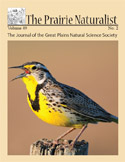Great Plains Natural Science Society

The Prairie Naturalist
Date of this Version
12-2010
Document Type
Article
Citation
The Prairie Naturalist 42(3/4):145-147; 2010, pp 145-147
Abstract
Knowledge of spawning areas can benefit fisheries management (Marsden et al. 1991). Identification of spawning areas allows managers to protect, enhance, and/or restore critical habitat (Gunn et al. 1996, Thompson 2009), examine important biotic and abiotic conditions necessary for reproduction (Quist et al. 2003), and to efficiently collect broodstock for production (Satterfield and Flickinger 1996). The most effective method to directly identify spawning areas of fish with demersal eggs is to sample the substrate for eggs (Marsden et al. 1991). This method has been used to locate spawning areas of several species (Michaletz 1984, Zorn et al. 1998, Martin 2008). However, direct estimation of egg deposition is time consuming and requires specialized equipment which often makes this method impractical. A more practical approach may be to indirectly identifY spawning areas by sampling congregations of mature fish during the spawning season. Mature male walleye (Sander vitreus) will congregate during the spawning season on the spawning grounds and remain there for the duration of the spawn (Scott and Crossman 1973). In contrast, mature female walleye will stage near the spawning grounds before moving onto the spawning ground to release their eggs, and will then return to the staging area within a single night (Scott and Crossman 1973, Thompson 2009). This sex-specific behavior suggests that locating male walleye as opposed to females may be more reliable for locating where egg deposition is occurring.
Included in
Biodiversity Commons, Botany Commons, Ecology and Evolutionary Biology Commons, Natural Resources and Conservation Commons, Systems Biology Commons, Weed Science Commons

